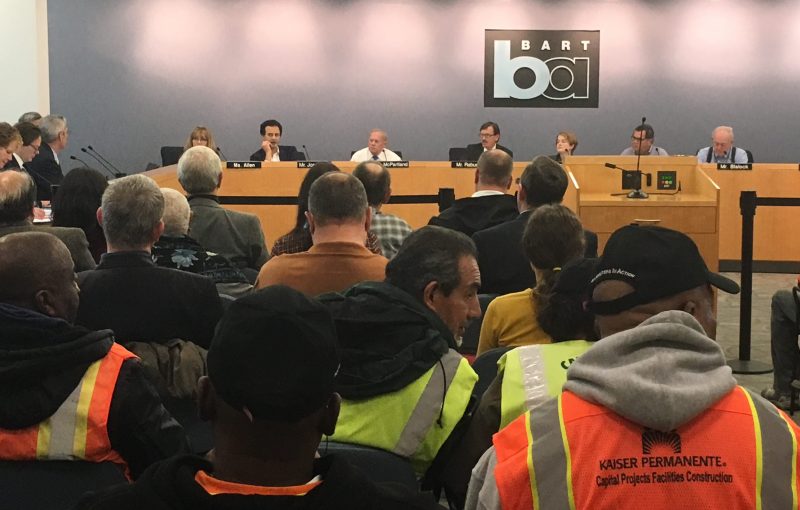At yesterday's BART board meeting directors Nick Josefowitz and newly elected Lateefah Simon introduced a proposal to make BART a "sanctuary space" for immigrants. That proposal will be considered later. Meanwhile the board approved removing seats from BART cars to create more standing room. They also voted to buy new bike lockers, update old ones, and begin a pilot program to allow people to use Clipper cards to pay for them.
And they delayed approving a parking garage at the Dublin BART station that has been on the books for years.
The room was packed for the garage discussion with reps from local labor unions, who said it would create jobs. “We did our part” drumming up support for sales tax Measure RR, said Andreas Gruber of the Building Trades Council. A representative from Assemblymember Catherine Baker's office pushed the board to approve the garage. The vice mayor of Dublin spoke of the high demand for parking around the Dublin station.
But even BART staff acknowledged that the garage could violate the board's recently adopted Station Access Policy. That policy states that even at “auto-dependent” stations like Dublin, parking should be considered only after investments are made in walking, biking, and transit infrastructure.
Dublin is one of the most car-centric stations in the BART system. There is already a BART-owned parking structure with 1500 spaces, but access to the station for bicyclists and pedestrians is poor. Representatives from TransForm and Bike East Bay pointed out that Dublin, BART, and the City of Pleasanton have developed a plan to improve bicycle and pedestrian access to the station, the Iron Horse Trail Feasibility Study, but that its recommendations are not included in the parking garage plan.
The city of Dublin approved the Environmental Impact Report for the garage in 2002. In letters submitted to the board, the Sierra Club and the Transportation Solutions Defense and Education Fund both pointed out that that EIR is outdated, as state environmental law has changed in substantial ways since then.
The new parking garage would add 540 spaces, far less than what proponents say demand is. Although there is money available for design, no one could answer where the construction cost of $28 million would come from.
While there is some expectation of receiving funds from the recently passed BART bond/Measure RR, BART General Manager Grace Cunican told the board that there is as yet no priority list for that funding. Director Rebecca Saltzman wondered if it was “appropriate to jump into a project design when we don't know where the funding will come from, or what Measure RR priorities are.”
Furthermore, said Saltzman, the cost per parking space would come to about $69,000, which compares badly with the new bike lockers the board was considering—and ultimately approved—at about $3400 per bike parking space.
Josefowitz floated a proposal to delay approval for ninety days, giving staff time to answer questions about funding sources, to investigate alternative ways of providing the new parking spaces, and to come up with a plan that better aligns with the Station Access Plan.
Newly elected Director Debora Allen was adamant that the garage be approved. “This was planned fifteen years ago,” she said. “It's time to build it. Cars matter too.”
She even tried to rile up the labor union audience. “My fellow directors,” said Allen, “are using the cost of construction as an excuse to kill the construction of this project. Think about that.”
“I am purely interrogating where the money would come from,” responded Director Simon. “Ultimately, we want to make the best decision for riders, for workers, and residents.” Director Thomas Blalock acknowledged that “normally I would vote against this motion, because my experience at BART tells me that delay could kill a project.” But a ninety-day delay for staff to revisit the plan is reasonable, he said.
Director Robert Raburn agreed with putting off a decision, because of the project's “extraordinary cost and inadequate design.” The Dublin station is deemed a Priority Development Area, “and PDAs are called to meet smart growth policies, which include more than just adding parking” around transit, he said. “The project is not multimodal, and we know we need better bike and pedestrian access at the station. We need to meet our own access policy,” as well as endeavor to meet [state planning] goals around sustainability, he said.
Ultimately the motion to delay passed unanimously, with even Director Allen deciding that a ninety-day wait was tolerable.
Staff will present a follow-up plan at the BART Planning Committee in April.






